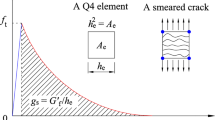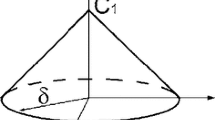Abstract
This study is aimed at evaluating continuum scale predictions of dynamic crack propagation and branching in brittle materials using local damage modeling. Classical experimental results on crack branching in PMMA and the corresponding nonlocal modeling results by Wolff et al. (Int J Numer Meth Eng 101(12):933, 2015) are used as a benchmark. An isotropic damage model based on a frame-invariant effective strain is adapted. Mesh objectivity is achieved by calibrating the damage model for a suitable element size and subsequently retaining that mesh size in all subsequent analyses. Crack propagation and branching are predicted by simulating accurately the test conditions. It is found that a local, rate-independent damage model considerably overpredicts the dynamic crack velocity and the extent of crack branching. Subsequently, the effect of various strain rate-dependent phenomena, viz. material viscoelasticity, rate-dependent strength, fracture energy, and failure strain is evaluated. Incorporating the material strain rate effects is found to improve the predictions and match the test data. In this regard, radially scaling the damage law is found to work the best. Despite an overprediction of micro-branching, the macro-crack branching is found to occur in agreement with the Yoffe instability criterion. Overall, various experimentally observed aspects of dynamic cracks are reproduced, including acceleration of cracks to a steady state velocity, increased micro-branching and macro-branching with increased strain rates, and crack velocity dependence of energy dissipation and fracture surface area.
















Similar content being viewed by others
References
Abraham FF (2005) Unstable crack motion is predictable. J Mech Phys Solids 53(5):1071
Allix O, Deü JF (1997) Delayed-damage modelling for fracture prediction of laminated composites under dynamic loading. Eng Trans 45(1):29
Barenblatt GI et al (1962) The mathematical theory of equilibrium cracks in brittle fracture. Adv Appl Mech 7(1):55
Bažant ZP, Caner FC (2014) Impact comminution of solids due to local kinetic energy of high shear strain rate: I. Continuum theory and turbulence analogy. J Mech Phys Solids 64:223
Bažant ZP, Gettu R (1992) Rate effects and load relaxation in static fracture of concrete. ACI Mater J 89(5):456
Bazant ZP, Li YN (1997) Cohesive crack with rate-dependent opening and viscoelasticity: I. mathematical model and scaling. Int J Fract 86(3):247
Bažant ZP, Oh BH (1983) Crack band theory for fracture of concrete. Mat Construct 16(3):155
Bažant ZP, Pijaudier-Cabot G (1989) Rate-dependent scaling of dynamic tensile strength of quasibrittle structures. J Eng Mech 115(4):755
Bazant ZP, Planas J (1997) Fracture and size effect in concrete and other quasibrittle materials, vol 16. CRC Press, Boca Raton
Bazant ZP, Planas J (1997) Fracture and size effect in concrete and other quasibrittle materials, vol 16. CRC Press, Boca Raton
Bleyer J, Molinari JF (2017) Microbranching instability in phase-field modelling of dynamic brittle fracture. Appl Phys Lett 110(15):151903
Bleyer J, Roux-Langlois C, Molinari JF (2017) Dynamic crack propagation with a variational phase-field model: limiting speed, crack branching and velocity-toughening mechanisms. Int J Fract 204(1):79
Bolander JE, Sukumar N (2005) Irregular lattice model for quasistatic crack propagation. Phys Rev B 71(9):094106
Broberg K (1996) How fast can a crack go? Mater Sci 32(1):80
Camacho GT, Ortiz M (1996) Computational modelling of impact damage in brittle materials. Int J Solids Struct 33(20–22):2899
Červenka J, Bažant ZP, Wierer M (2005) Mechanism-based energy regularization in computational modeling of quasibrittle fracture. Int J Numer Meth Eng 62(5):700
Doan DH, Bui TQ, Van Do T, Duc ND (2017) A rate-dependent hybrid phase field model for dynamic crack propagation. J Appl Phys 122(11):115102
Dugdale DS (1960) Yielding of steel sheets containing slits. J Mech Phys Solids 8(2):100
Ebeida MS, Mitchell SA (2011) Proceedings of the 20th international meshing roundtable. Springer, Berlin, pp 273–290
F Zhou (1996) Study on the macroscopic behavior and the microscopic process of dynamic crack propagation. Ph.D. thesis, The University of Tokyo, Tokyo
Fenghua Z, Lili W, Shisheng H et al (1992) Explosion and Shock waves 4
Fineberg J (1997) APS, pp F4–02
Fineberg J, Marder M (1999) Instability in dynamic fracture. Phys Rep 313(1–2):1
Freund LB (1998) Dynamic fracture mechanics. Cambridge University Press, Cambridge
Gorgogianni A, Eliáš J, Le JL (2020) Measurement of characteristic length of nonlocal continuum. J Appl Mech 87:9
Graebling D, Muller R, Palierne J (1993) Linear viscoelastic behavior of some incompatible polymer blends in the melt. Interpretation of data with a model of emulsion of viscoelastic liquids. Macromolecules 26(2):320
Hernández-Jiménez A, Hernández-Santiago J, Macias-Garcıa A, Sánchez-González J (2002) Relaxation modulus in PMMA and PTFE fitting by fractional Maxwell model. Polym Testing 21(3):325
Jia JH, Shen XY, Hua HX (2007) Viscoelastic behavior analysis and application of the fractional derivative Maxwell model. J Vib Control 13(4):385
JiráSek M, Bauer M (2012) Numerical aspects of the crack band approach. Comput Struct 110:60
Jirásek M, Grassl P (2008) Evaluation of directional mesh bias in concrete fracture simulations using continuum damage models. Eng Fract Mech 75(8):1921
Jirásek M, Rolshoven S (2003) Comparison of integral-type nonlocal plasticity models for strain-softening materials. Int J Eng Sci 41(13–14):1553
Jo C, Fu J, Naguib HE (2005) Constitutive modeling for mechanical behavior of PMMA microcellular foams. Polymer 46(25):11896
John R, Shah SP (1986) Fracture of concrete subjected to impact loading. Cem Concret Aggregat 8(1):24
Kachanov L (1986) Introduction to continuum damage mechanics, vol 10. Springer, New York
Kirane K, Su Y, Bažant ZP (2015) Strain-rate-dependent microplane model for high-rate comminution of concrete under impact based on kinetic energy release theory. Proc R Soc A 471(2182):20150535
Knauss W (1970) Delayed failure” the Griffith problem for linearly viscoelastic materials. Int J FractMech 6(1):7
Ladeveze P (1992) A damage computational method for composite structures. Comput Struct 44(1–2):79
Leon S, Spring D, Paulino G (2014) Reduction in mesh bias for dynamic fracture using adaptive splitting of polygonal finite elements. Int J Numer Meth Eng 100(8):555
Li T, Marigo JJ, Guilbaud D, Potapov S (2016) Gradient damage modeling of brittle fracture in an explicit dynamics context. Int J Numer Meth Eng 108(11):1381
Luo W, Chau VT, Bažant ZP (2019) Effect of high-rate dynamic comminution on penetration of projectiles of various velocities and impact angles into concrete. Int J Fract 216(2):211
Mazars J (1986) A description of micro-and macroscale damage of concrete structures. Eng Fract Mech 25(5–6):729
Molinari JF, Gazonas G, Raghupathy R, Rusinek A, Zhou F (2007) The cohesive element approach to dynamic fragmentation: the question of energy convergence. Int J Numer Meth Eng 69(3):484
Needleman A (1988) Material rate dependence and mesh sensitivity in localization problems. Comput Methods Appl Mech Eng 67(1):69
Nguyen VP, Wu JY (2018) Modeling dynamic fracture of solids with a phase-field regularized cohesive zone model. Comput Methods Appl Mech Eng 340:1000
Nguyen H, Pathirage M, Rezaei M, Issa M, Cusatis G, Bažant ZP (2020) New perspective of fracture mechanics inspired by gap test with crack-parallel compression. Proc Natl Acad Sci 117:14015–14020
Pandolfi A, Ortiz M (2002) An efficient adaptive procedure for three-dimensional fragmentation simulations. Eng Comput 18(2):148
Pandolfi A, Krysl P, Ortiz M (1999) Finite element simulation of ring expansion and fragmentation: the capturing of length and time scales through cohesive models of fracture. Int J Fract 95(1):279
Papoulia KD, Sam CH, Vavasis SA (2003) Time continuity in cohesive finite element modeling. Int J Numer Meth Eng 58(5):679
Pereira L, Weerheijm J, Sluys L (2015) In 9th International conference on fracture mechanics of concrete and concrete structures (FraMCos-9), p 14
Pontiroli C (1995) Comportement au souffle des structures en béton armé: analyse expérimentale et modélisation. Ph.D. thesis, Cachan, Ecole normale supérieure
Rabbi MF, Chalivendra VB (2019) Mathematical modeling of viscoelastic material under impact load. J Strain Anal Eng Design 54(2):130
Rabbi M, Chalivendra V, Li D (2019) A novel approach to increase dynamic fracture toughness of additively manufactured polymer. Exp Mech 59(6):899
Ravi-Chandar K, Knauss W (1984) An experimental investigation into dynamic fracture: III. On steady-state crack propagation and crack branching. Int J Fract 26(2):141
Repetto E, Radovitzky R, Ortiz M (2000) Finite element simulation of dynamic fracture and fragmentation of glass rods. Comput Methods Appl Mech Eng 183(1–2):3
Schapery R (1989) On the mechanics of crack closing and bonding in linear viscoelastic media. Int J Fract 39(1–3):163
Scheibert J, Guerra C, Bonamy D, Dalmas D (2012) Understanding fast macroscale fracture from microcrack post mortem patterns, EGUGA, p 10337
Sharon E, Gross SP, Fineberg J (1995) Local crack branching as a mechanism for instability in dynamic fracture. Phys Rev Lett 74(25):5096
Sharon E, Gross SP, Fineberg J (1996) Energy dissipation in dynamic fracture. Phys Rev Lett 76(12):2117
Simulia (2017) ABAQUS user’s manual, version 2017. Dassault Systemes Simulia Corp., Providence, RI
Sluys L, De Borst R, Mühlhaus HB (1993) Wave propagation, localization and dispersion in a gradient-dependent medium. Int J Solids Struct 30(9):1153
Wang J, Xu Y, Zhang W (2014) Finite element simulation of PMMA aircraft windshield against bird strike by using a rate and temperature dependent nonlinear viscoelastic constitutive model. Compos Struct 108:21
Williams J (1972) Visco-elastic and thermal effects on crack growth in PMMA. Int J FractMech 8(4):393
Willis J (1967) Crack propagation in viscoelastic media. J Mech Phys Solids 15(4):229
Wolff C, Richart N, Molinari JF (2015) A non-local continuum damage approach to model dynamic crack branching. Int J Numer Meth Eng 101(12):933
Wu JY (2017) A unified phase-field theory for the mechanics of damage and quasi-brittle failure. J Mech Phys Solids 103:72
Wu JY, Nguyen VP (2018) A length scale insensitive phase-field damage model for brittle fracture. J Mech Phys Solids 119:20
Xu XP, Needleman A (1994) Numerical simulations of fast crack growth in brittle solids. J Mech Phys Solids 42(9):1397
Xu D, Liu Z, Liu X, Zeng Q, Zhuang Z (2014) Modeling of dynamic crack branching by enhanced extended finite element method. Comput Mech 54(2):489
Xue J, Kirane K (2019) Strength size effect and post-peak softening in textile composites analyzed by cohesive zone and crack band models. Eng Fract Mech 212:106
Yazid A, Abdelkader N, Abdelmadjid H (2009) A state-of-the-art review of the X-FEM for computational fracture mechanics. Appl Math Model 33(12):4269
Yoffe EH (1951) LXXV. The moving griffith crack. Lond Edinb Dublin Philosoph Mag J Sci 42(330):739
Zhou F, Molinari JF, Shioya T (2005) A rate-dependent cohesive model for simulating dynamic crack propagation in brittle materials. Eng Fract Mech 72(9):1383
Zi G, Chen H, Xu J, Belytschko T (2005) The extended finite element method for dynamic fractures. Shock Vibrat 12(1):9
Acknowledgements
Research was sponsored by the Army Research Office and was accomplished under Grant number W911NF-19-1-0312. The views and conclusions contained in this document are those of the authors and should not be interpreted as representing the official policies, either expressed or implied, of the Army Research Office or the US Government. The US Government is authorized to reproduce and distribute reprints for Government purposes notwithstanding any copyright notation herein.
Author information
Authors and Affiliations
Corresponding author
Ethics declarations
Conflict of interest
The authors declare that they have no conflict of interest.
Additional information
Publisher's Note
Springer Nature remains neutral with regard to jurisdictional claims in published maps and institutional affiliations.
Rights and permissions
About this article
Cite this article
Abdullah, T., Kirane, K. Continuum damage modeling of dynamic crack velocity, branching, and energy dissipation in brittle materials. Int J Fract 229, 15–37 (2021). https://doi.org/10.1007/s10704-021-00537-8
Received:
Accepted:
Published:
Issue Date:
DOI: https://doi.org/10.1007/s10704-021-00537-8




